In this tutorial, multi-body dynamics analysis (simulation type: Transient Analysis) of a slender cantilever beam will be performed using OptiStruct. An existing finite element model of a cantilever beam will be imported into HyperMesh. The rest of the setup (creation of joint, loading, etc.) is also done in HyperMesh. HyperView is used to post-process the large displacement results of a cantilever beam model.
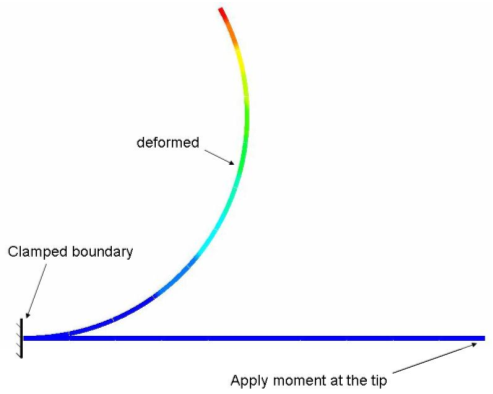
In this tutorial, you learn how to create a JOINT, a PFBODY, an MBMNTC and a multi-body dynamics subcase.
The beam model consists of 10 different flexible bodies (PFBODY) and each body is to be connected through a fixed joint and rigid element (RBE2).

Modeling RBE2
There are two RBE2’s defined at the boundary of each body (one for each body at this boundary). The fixed joint will be created using coincident nodes which are independent nodes of each of the RBE2s.
These exercises show how to:
| • | Load a model into HyperMesh |
| • | Create a component for JOINT |
| • | Create load collectors for MBMNTC and MBSIM |
| • | Create a multi-body dynamics subcase |
| • | Post-process the results in HyperView |
Exercise
Step 1: Retrieve the structural model and define the OptiStruct template
| 1. | Launch HyperMesh Desktop. |
| 2. | Set the User Profiles to OptiStruct and click OK. |
| 3. | Click File > Open > Model. |
| 4. | Select the cantilever_beam_MBD.hm file you saved to your working directory from the optistruct.zip file. Refer to Accessing the Model Files. |
Creating Joints (Steps 2 - 4)
Here, all the necessary joints required for this model are defined. Only fixed joints for this model are needed.
Step 2: Create components for JOINT
| 1. | In the Model browser, right-click and select Create > Component. |
| 2. | For Name, enter joints. |
| 3. | Click Color and select any color. |
This creates the new component named joints.
Step 3: Create a JOINT for the clamped boundary condition
The fix joint at the left corner of body_1 will be created to represent clamped boundary condition. This fixed joint will be created using coincident nodes, so that coincident nodes need to be created first at the left corner of body_1.
| 1. | Click Geometry > Create > Nodes > XYZ to open the Create Nodes panel. |
| 2. | Move the cursor to the upper left corner of body_1 and click three times (see the following figure). You will get the nodal coordinate (x=, y=, z=) of that node. |

Location of coincident nodes
| 4. | Repeat the last two steps to create another coincident node at lower left corner of body_1. |
| 6. | Click Mesh > Create > 1D Elements > Joints to open the Joints panel. |
| 7. | Click the joint type: selector switch and select fixed from the pop-up menu. |
| 8. | Click node under first terminal: and select one of the coincident nodes at upper left corner node. |
| Note: | To select the coincident nodes, the coincident picking option has to be turned on, to do this: |
- From the Preferences menu on the toolbar, select Options.
- Select the graphics subpanel.
- Check the box for coincident picking.
- Click return to return to the joints panel.
|
| 9. | Under second terminal:, click node and select the other coincident nodes at the same location. |

Fixed joint
| 11. | Repeat this process to create a fixed joint at lower left corner of body_1. |
Step 4: Create a fixed joint for each boundary of components
Fix joint will be created at the boundary of each component.
| 1. | Click Mesh > Create > 1D Elements > Joints to open the Joints panel. |
| 2. | Click the joint type: selector switch and select fixed. |
| 3. | Zoom in to the boundary between Body_1 and Body_2. |
| 4. | Select one of the coincident nodes as first terminal (see the following figure). |
| 5. | Select the other coincident nodes as second terminal. |
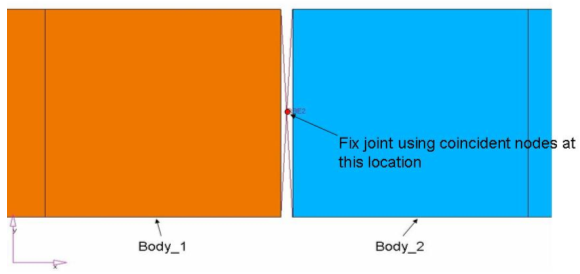
Fixed joint
| 7. | Repeat this process to create a fixed joint for the boundary of each body. |
Step 5: Creating PFBodies
PFBODY is the Flexible Body Definition for Multi-body Simulation. PFBODY defines a flexible body out of a list of finite element properties, elements, and grid points.
You will have ten bodies apart from the ground body in your model.
Define the parts as PFBODY (Flexible Body definition)
| 1. | From the Analysis page, click bodies. |
| 2. | Select the create subpanel. |
| 3. | Click body= and enter pfbdy_1. |
| 4. | Click type= and select PFBODY. |
| 5. | Click props and check the box for body_1. |
| 7. | Click elems and select by collector from the pop-up menu. |
| 8. | Check the box for the component rigid_1 and click select. |
| 9. | Use the toggle for number of modes: to switch from nmodes default to nmodes=. |
| 10. | Click nmodes= and enter 3. |
| 12. | Switch over to the parameters subpanel using the radio buttons on the left-hand side of the panel. |
| 13. | Use the damping: toggle to change from damping default to dval=. |
| 14. | Click dval= and enter 10.0. |
| 16. | Repeat this process to create a PFBODY for each flexible body. |
For example, for body_2:
body= pfbdy_2,
props= body_2,
elems = rigid_2, and so on.
Make sure that all PFBODY have a damping of 10.0 defined in parameters subpanel. For pfbody_4 enter a value of 7 in the nmodes= field.
Defining External Inputs and Simulation Parameters (Steps 6 - 8)
The moment applied at the end of the beam, the gravity force that applies to the model and MBSIM bulk data card, which is to specify the parameter for multi body simulation, will be created in this step.
Step 6: Create DTI, UNITS
| 1. | Click Setup > Create > Control Cards to open the Control Cards panel. |
| 3. | Define the unit system, shown below. |

Step 7: Create load collector for MBSIM
| 1. | In the Model browser, right-click and select Create > Load Collector. |
| 2. | For Name, enter mbmoment. Make sure Card Image is set to None. |
| 3. | In the Model browser, right-click and select Create > Load Collector. |
| 5. | For Card Image, select MBSIM from the list. |
| 7. | In the TIME field, enter 0.5. |
| 8. | For STYPE, select DELTA. |
| 9. | In the DELTA field, enter 2.0e-04. |
| 10. | Change ITYPE to VSTIFF. |
Step 8: Create an MBMNTC
First, load types for moment need to be changed to MBMNTC. moment is the default.
| 1. | From the Analysis page, select load types. |
| 2. | Click moment= and select MBMNTC. |
| 3. | Click return. MBMNTC is the moment based on the curve so that the curve will be created next. |
| 4. | Click XYPlots > Curve Editor to bring up the Curve editor window. |
| 6. | For name =, enter mycurve. |
| 8. | Select mycurve from the Curve List: located in upper left corner of the window. |
| 9. | Populate the X Y table, as shown here: |
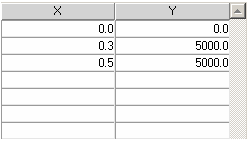
| 11. | Expand the Load Collector folder in the Model browser. |
| 12. | Right-click on mbmoment and click Make Current. |
| 13. | From the Analysis page, click moments. |
| 15. | Select the 2 nodes at right tip of a beam, as shown in the following figure. |

MBMNTC
| 16. | Click the switch beside magnitude= and change to curve, components. |
| 17. | In the z comp= field, enter 1.0. |
| 18. | The x comp, y comp should remain at 0. |
| 21. | Click create > return. |
Step 9: Create an OptiStruct subcase
| 1. | Click Setup > Create > LoadSteps to open the LoadSteps panel. |
| 2. | Set the Analysis type to Multi-body dynamics. |
| 3. | For Name, enter Dynamic. |
| 4. | For MBSIM, click Unspecified > Loadcol. |
| 5. | In the Select Loadcol dialog, select sim from the list of load collectors and click OK. |
| 6. | For MLOAD, click Unspecified > Loadcol. |
| 7. | In the Select Loadcol dialog, select mbmoment from the list of load collectors and click OK. |
Step 10: Submit the job
| 1. | From the Analysis page, enter the OptiStruct panel. |
| 2. | Click save as following the input file: field. A Save As browser window opens. |
| 3. | Select the directory where you would like to write the OptiStruct model file and enter the name for the model, cantilever_beam_MBD.fem, in the File name: field. The .fem file name extension is the suggested extension for OptiStruct input decks. |
The name and location of the cantilever_beam_MBD.fem file displays in the input file: field.
| 5. | Set the memory options: toggle to memory default. |
| 6. | Set the run options: toggle to analysis. |
| 7. | Set the export options: toggle to all. |
| 8. | Click OptiStruct. This launches an OptiStruct run in a separate shell (DOS or UNIX) which appears. |
If the optimization was successful, no error messages are reported to the shell. The optimization is complete when the message Processing complete appears in the shell.
Step 11: View the Results in HyperView
This step describes how to view the results in HyperView.
HyperView is a complete post-processing and visualization environment for finite element analysis (FEA), multi-body system simulation, video and engineering data.
View a contour plot of the displacement and stress
| 1. | While in the OptiStruct panel of the Analysis page, click HyperView. |
Note that the path and file name for cantilever_beam_MBD.h3d appears in the fields to the right of Load model and Load results. This is fine because the .h3d format contains both model and results data.
The model and results are loaded in the current HyperView window.
| 2. | Click the Contour toolbar icon  . . |
| 3. | For Result type: select Displacement(v). |
| 5. | Verify that the Animate Mode is set to Transient. |
| 6. | Click the Start/Pause Animation icon to start the animation. |
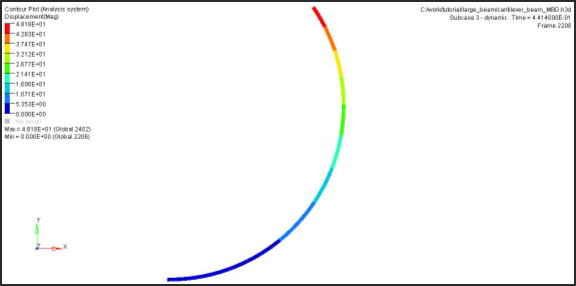
| 7. | The Animation Controls are in the panel next to the playback controls. |

The HyperView playback controls
| 8. | With the animation running, use the bottom slider bar to adjust the speed of the animation. |
| 9. | Click the Start/Pause Animation icon again to stop the animation. |
| 10. | For Result type:, select Element Stresses (2D & 3D) (t). |
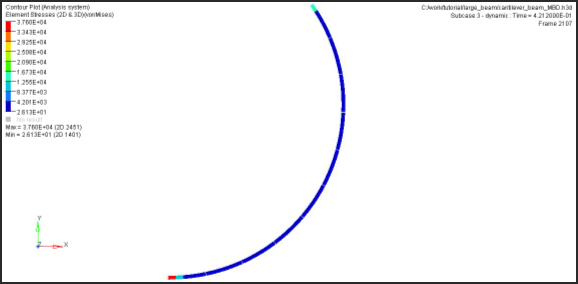
See Also:
OptiStruct Tutorials


















